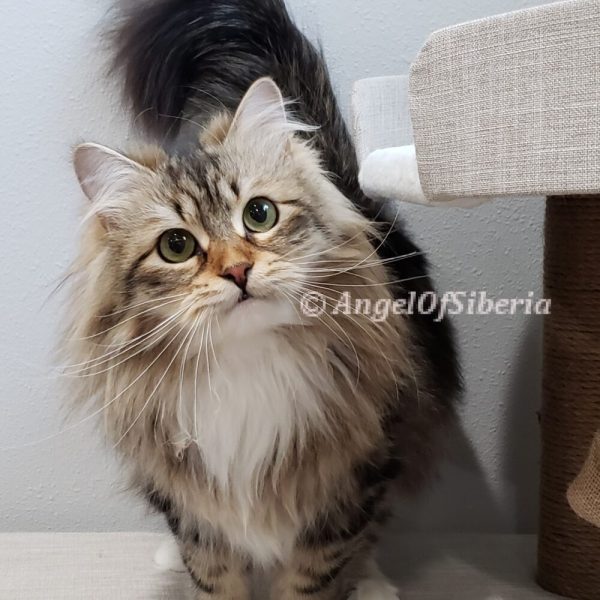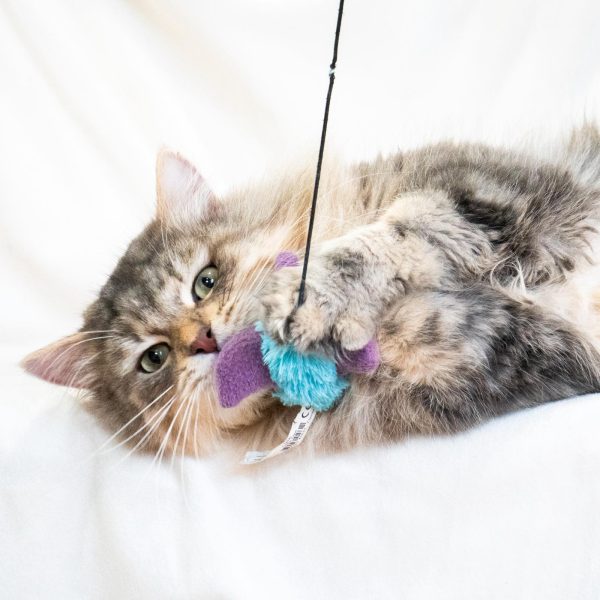TEST Angel of Siberia
The “Cat Allergen” is called FEL D1. The primary sources of FEL D1 are (1) secretions from the glands of the skin and (2) what is left on the fur from the saliva when the cats clean themselves. Eventually these allergens flake off and become airborne, triggering allergic reactions.
The Siberian Cat produces a REDUCED LEVEL of FEL D1, due to a protein sequence missing from their DNA. Only pure-bred Siberian cats will have this genetic advantage, so choose your Siberian Breeder carefully if the hypo-allergenic trait is one of the benefits of interest to you!
It is important to note that the DEGREE to which individuals react or don’t react to a Siberian can vary from cat to cat, and color to color. Therefore, if your allergies are moderate to severe, you should choose a local breeder and test your allergies with the kitten you will be bringing home with you
Hypoallergenic means less allergenic. There is no non allergenic cat. A common misconception is that allergen is caused by cat hair, which is why a lot of people do not believe in a long haired breed, such as a Siberian cat. Cats produce a protein in their saliva, called FEL D1. This protein contains the allergen level. Because the cats groom themselves, the saliva with FEL D1 protein ends up on the coat, and causes dander. Siberians produce much less of this FEL D1 allergen protein than any other breed.
Because of this the Siberian cat is often a good choice for people who suffer from allergies.


Allergy testing is not always an easy solution. It is a very short and quick exposure to cat saliva and dander, and everyone has their own personal unique allergies. The allergy testing is a one-hour process with a $50 testing fee. The testing fee goes toward your $400 deposit to reserve a kitten. If the test does not go well, then the testing fee is just for my time. When you visit my home for allergy testing, I will expose one cat at a time for a certain amount of time to see how that type of cats’ fur/saliva is tolerated. Exposure to all my cats at once may be overwhelming for the allergies, since everyone’s allergies are personal and unique. For example, contact allergies, when the person physically touches a cat to see if they will break out in hives. Other examples include sniffly sneezing allergies and asthma type allergies.
*Please wear long sleeves and long pants that are non-snagging as cats do have claws.
Your body needs time to build up immunity to a kitten. Up until now, your home has been cat-free. No litter, fur, dander, cat tree, and cat walking all over your stuff. Suddenly, you are hit with the invasion of a cat. Your eyes and nose may be runny, you are starting to itch, and wondering what you have gotten yourself into. However, the kitten feels the same way. The kitten is stressed out in this new environment and this causes the allergen levels to spike until the kitten gets settled in.
Expect the adjustment period to last 1-2 weeks. The kitten needs to calm down and get used to the new place, new food, new smells, new noises, and new environment, just as your body needs a few weeks to adjust and build a tolerance. The change from no dander in your home to low levels of it may cause you to experience some allergy symptoms for the first couple weeks, but eventually it should remain minor, taper off and be fine. If you get violently ill, you need to call me immediately and return the kitten.
*Siberians are low in allergens; however, intact Siberians have more allergens than after they are spayed/neutered. The first 30 days after a cat is spayed/neutered, the proteins start coming down even further.
*The bottom line is a person with allergies needs to build up a tolerance to their cat they are living with, and this takes time. For example, when you go to the doctor for a flu shot, you are injected with a minor dose of the flu. Same thing here, when you bring a low allergen Siberian into your home, your body still needs to adapt. A Siberian cat is hypo-allergenic meaning it has a LOW allergen response, not NO allergen response.




